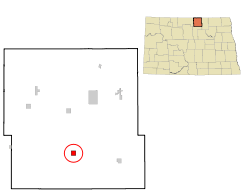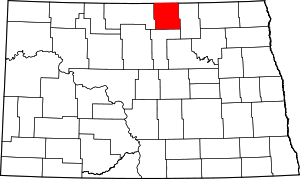Rolette, North Dakota
Rolette is a city in Rolette County, North Dakota, United States. The population was 594 at the 2010 census.[5]
Rolette, North Dakota | |
|---|---|
 Location of Rolette, North Dakota | |
| Coordinates: 48°39′48″N 99°50′39″W | |
| Country | United States |
| State | North Dakota |
| County | Rolette |
| Area | |
| • Total | 1.01 sq mi (2.61 km2) |
| • Land | 1.01 sq mi (2.61 km2) |
| • Water | 0.00 sq mi (0.00 km2) |
| Elevation | 1,627 ft (496 m) |
| Population | |
| • Total | 594 |
| • Estimate (2019)[3] | 593 |
| • Density | 588.29/sq mi (227.23/km2) |
| Time zone | UTC-6 (Central (CST)) |
| • Summer (DST) | UTC-5 (CDT) |
| ZIP code | 58366 |
| Area code(s) | 701 |
| FIPS code | 38-67780 |
| GNIS feature ID | 1030956[4] |
| Website | rolettend.com |
History
Rolette was founded in 1905, and was incorporated in 1930.[6] The city took its name from Rolette County.[6] A post office has been in operation at Rolette since 1905.[7]
Geography
Rolette is located at 48°39′48″N 99°50′39″W (48.663463, -99.844187).[8]
According to the United States Census Bureau, the city has a total area of 1.00 square mile (2.59 km2), all of it land.[9]
Demographics
| Historical population | |||
|---|---|---|---|
| Census | Pop. | %± | |
| 1910 | 408 | — | |
| 1920 | 409 | 0.2% | |
| 1930 | 428 | 4.6% | |
| 1940 | 460 | 7.5% | |
| 1950 | 451 | −2.0% | |
| 1960 | 524 | 16.2% | |
| 1970 | 579 | 10.5% | |
| 1980 | 667 | 15.2% | |
| 1990 | 623 | −6.6% | |
| 2000 | 538 | −13.6% | |
| 2010 | 594 | 10.4% | |
| Est. 2019 | 593 | [3] | −0.2% |
| U.S. Decennial Census[10] 2018 Estimate[11] | |||
2010 census
At the 2010 census there were 594 people in 254 households, including 141 families, in the city. The population density was 594.0 inhabitants per square mile (229.3/km2). There were 284 housing units at an average density of 284.0 per square mile (109.7/km2). The racial makup of the city was 56.9% White, 0.2% African American, 37.9% Native American, 0.2% from other races, and 4.9% from two or more races. Hispanic or Latino of any race were 1.0%.[2]
Of the 254 households 29.5% had children under the age of 18 living with them, 35.0% were married couples living together, 15.0% had a female householder with no husband present, 5.5% had a male householder with no wife present, and 44.5% were non-families. 39.0% of households were one person and 16.5% were one person aged 65 or older. The average household size was 2.19 and the average family size was 2.92.
The median age was 43 years. 24.1% of residents were under the age of 18; 7.9% were between the ages of 18 and 24; 19.4% were from 25 to 44; 25.1% were from 45 to 64; and 23.6% were 65 or older. The gender makeup of the city was 48.1% male and 51.9% female.
2000 census
At the 2000 census, there were 538 people in 243 households, including 140 families, in the city. The population density was 535.4 people per square mile (207.7/km2). There were 286 housing units at an average density of 284.6 per square mile (110.4/km2). The racial makup of the city was 75.46% White, 21.00% Native American, and 3.53% from two or more races.
Of the 243 households 26.7% had children under the age of 18 living with them, 42.4% were married couples living together, 11.9% had a female householder with no husband present, and 42.0% were non-families. 40.7% of households were one person and 18.1% were one person aged 65 or older. The average household size was 2.02 and the average family size was 2.70.
The age distribution was 20.6% under the age of 18, 6.9% from 18 to 24, 20.8% from 25 to 44, 22.7% from 45 to 64, and 29.0% 65 or older. The median age was 46 years. For every 100 females, there were 94.2 males. For every 100 females age 18 and over, there were 85.7 males.
The median household income was $27,500 and the median family income was $36,563. Males had a median income of $28,750 versus $21,827 for females. The per capita income for the city was $15,742. About 12.8% of families and 16.8% of the population were below the poverty line, including 27.9% of those under age 18 and 7.3% of those age 65 or over.
Notable people
- Kevin Cramer, U.S. Senator, former U.S. Representative
- Randy Kelly, Minnesota legislator and mayor of Saint Paul, Minnesota
- William C. Marcil, chief executive officer of Forum Communications
References
- "2019 U.S. Gazetteer Files". United States Census Bureau. Retrieved July 27, 2020.
- "U.S. Census website". United States Census Bureau. Retrieved June 14, 2012.
- "Population and Housing Unit Estimates". United States Census Bureau. May 24, 2020. Retrieved May 27, 2020.
- "US Board on Geographic Names". United States Geological Survey. October 25, 2007. Retrieved January 31, 2008.
- "2010 Census Redistricting Data (Public Law 94-171) Summary File". American FactFinder. United States Census Bureau. Retrieved May 2, 2011.
- "Explain Origin of All County Towns". Turtle Mountain Star. September 5, 1940. p. 7. Retrieved May 2, 2015.
- "Rolette County". Jim Forte Postal History. Retrieved February 14, 2015.
- "US Gazetteer files: 2010, 2000, and 1990". United States Census Bureau. February 12, 2011. Retrieved April 23, 2011.
- "US Gazetteer files 2010". United States Census Bureau. Archived from the original on July 2, 2012. Retrieved June 14, 2012.
- United States Census Bureau. "Census of Population and Housing". Retrieved January 19, 2014.
- "Population Estimates". United States Census Bureau. Retrieved June 11, 2019.
